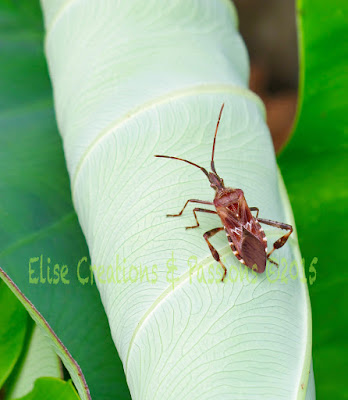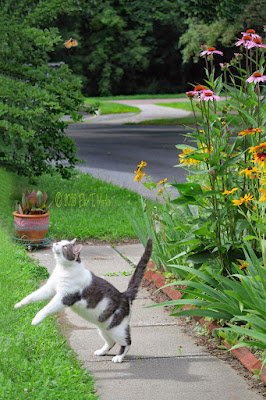In my garden.
Blue Black Wasp
Western Conifer Seed Bug
The Western Conifer Seed Bug feeds on the sap of developing conifer cones throughout its life, and its sap-sucking causes the developing seeds to wither and misdevelop. It is therefore considered a minor tree pest in North America.
Grapevine Beetle
The green tiger beetle is a large beetle with a metallic-green body, long blue-green spindly legs, and long, serrated antennae, and large mandibles. This common green ground beetle is also called the six-spotted green tiger beetle due to the recognizable cream-colored spots on its elytra.
The sizable, fast-moving shiny green tiger beetle grows up to 0.55” (14 mm). It is typically found in deciduous forests, feeding on small arthropods like caterpillars, spiders, and ants. The green tiger beetle is one of the fastest ground beetles and will fly if necessary.
Ladybug On A Wet Canna Leaf
Ladybugs also known as Ladybird beetles, Lady beetles, Ladybirds, or Lady cows, can have as many as 16 spots, but some ladybugs have no spots at all. One of the most common ladybugs is the seven-spotted lady beetle. It has seven black spots on its back.
While most ladybugs are good, there is one nonnative species that people don’t like. The Asian lady beetle was introduced in California in 1916. Today it’s more common in the East.
A ladybug can eat up to 50 aphids a day. They also eat Mites, Whiteflies, Scale insects, Mealybugs, & Thrips. This makes them valuable allies for farmers and gardeners. Their presence in an ecosystem is a sign of a healthy and diverse environment. Ladybugs not only provide natural pest control benefits to humans, but also serve as a vital food source for other insects, birds, and small mammals. By maintaining a delicate balance in the ecosystem, ladybugs promote stability and overall well-being.
Females will lay up to 1,000 eggs within a few months, generally from spring to early summer.
Ladybugs usually protect themselves from predators by either playing dead or they secrete a fluid from their legs to make themselves taste bad.
You can find out about 6,000 different species of ladybugs around the world. There are about 500 species in the United States alone.
It is a myth about ladybugs is that you can tell their age by their number of spots.


























